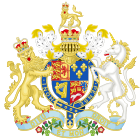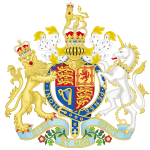- Marriage Act 1753
-
For other marriage-related legislation, see Marriage Act.
Marriage Act 1753 
Parliament of Great BritainStatute book chapter 26 Geo. II. c. 33 Dates Royal Assent 1754 Other legislation Repealing legislation Marriage Act 1823 (c.76), section 1 Status: Repealed The Marriage Act 1753, full title "An Act for the Better Preventing of Clandestine Marriage", popularly known as Lord Hardwicke's Marriage Act (citation 26 Geo. II. c. 33), was the first statutory legislation in England and Wales to require a formal ceremony of marriage. It came into force on 25 March 1754. The Act was precipitated by a dispute about the validity of a Scottish marriage,[1] although pressure to address the problem of clandestine marriage had been growing for some time.[2]
Contents
Background
Before the Act, the legal requirements for a valid marriage in England and Wales had been governed by the canon law of the Church of England. This had stipulated that banns should be called or a marriage licence obtained before a marriage could take place and that the marriage should be celebrated in the parish where at least one of the parties was resident.[3] However, these requirements were directory rather than mandatory and the absence of banns or a licence – or even the fact that the marriage was not celebrated in a church – did not render the marriage void. The only indispensable requirement was that the marriage be celebrated by an Anglican clergyman. The common but mistaken assumption that a simple exchange of consent would suffice is based on later, erroneous readings of ecclesiastical case law: such an exchange created a binding contract to marry rather than a legal marriage.[4]
Effects
The Act tightened the existing ecclesiastical rules regarding marriage, providing that for a marriage to be valid it had to be performed in a church and after the publication of banns[5] or the obtaining of a licence.[6] Jews and Quakers were exempted from its provisions, although the Act did not go so far as to declare such marriages valid and it was many years before their legal standing was assured. Nor did the Act apply to members of the British Royal Family. Indeed, members of the Royal Family have been consistently exempted from all general legislation relating to marriage since this date, which is why doubts were expressed in 2005 about the ability of Prince Charles to marry Camilla Parker-Bowles in a civil ceremony,[7] civil marriage being the creation of statute law.[8] It was also provided that the 1753 Act had no application to marriages celebrated overseas or in Scotland.[9]
The Act was highly successful in its stated aim of putting a stop to clandestine marriages, i.e., valid marriages performed by an Anglican clergyman but not in accordance with the canons. Thus the notorious practice of clandestine Fleet Marriages associated with London’s Fleet Prison was ended,[10] although there were various short-lived and abortive attempts to claim exemption for the Savoy Chapel in the Strand[11] and the parish of Temple in Cornwall. The early death of the Savoy’s minister on board ship while waiting to be transported for his flouting of the Act may have discouraged others from making similar claims, even if his demise was due to gout rather than to the conditions of his imprisonment.[12]
However, some couples evaded the Act by travelling to Scotland. Various Scottish “Border Villages” (Coldstream Bridge, Lamberton, Mordington and Paxton Toll) became known as places to marry. And in the 1770s the construction of a toll road passing through the hitherto obscure village of Graitney led to Gretna Green becoming synonymous with romantic elopements.
A similar traffic to the Isle of Man also sprang up, and in 1757 the Legislature of the Island passed an Act to prevent Clandestine Marriages [13] in very similar terms to the English Act of 1753. But the Manx Act differed in one significant respect from the latter, in requiring clergy from abroad, who were convicted of conducting marriages in breach of the Act's requirements, to be pilloried and have their ears cropped, before being imprisoned, fined and deported. The Act was repealed in 1849.[14]
Modern misinterpretation
Modern commentators, after the work of historians such as Lawrence Stone[15] and Stephen Parker[disambiguation needed
 ],[16] have often misconstrued both the requirements of the Act and the canon-law requirements which directly preceded it. It has been widely but wrongly asserted, for example, that the Act rendered invalid any marriage involving minors, i.e. those under 21, unless parental consent had been given.[17] In fact, this was true only for the minority of marriages celebrated by licence. While the parent of a minor could forbid the banns and so prevent a marriage from going ahead, a marriage by banns that took place without active parental dissent was valid. This gave rise to the practice whereby underage couples would resort to a parish where they were not resident to have the banns called without their parents' knowledge. Since the Act specifically prohibited the courts from inquiring into the parties' place of residence after the marriage had been celebrated, such evasive marriages were still valid.[18] The only way in which an aggrieved parent could challenge such a marriage was if there had been a mistake amounting to fraud in the calling of the banns.[19]
],[16] have often misconstrued both the requirements of the Act and the canon-law requirements which directly preceded it. It has been widely but wrongly asserted, for example, that the Act rendered invalid any marriage involving minors, i.e. those under 21, unless parental consent had been given.[17] In fact, this was true only for the minority of marriages celebrated by licence. While the parent of a minor could forbid the banns and so prevent a marriage from going ahead, a marriage by banns that took place without active parental dissent was valid. This gave rise to the practice whereby underage couples would resort to a parish where they were not resident to have the banns called without their parents' knowledge. Since the Act specifically prohibited the courts from inquiring into the parties' place of residence after the marriage had been celebrated, such evasive marriages were still valid.[18] The only way in which an aggrieved parent could challenge such a marriage was if there had been a mistake amounting to fraud in the calling of the banns.[19]It has also been mistakenly asserted that the Act abolished common-law marriage, along with informal folk-practices such as handfasting, broomstick weddings and mop weddings. However, since neither the name nor concept of “common-law marriage” existed in England and Wales at this time,[20] this can be shown to be untrue, while recent scholarship has argued that ideas such as handfasting and "broomstick" or “mop" weddings are the result of Victorian folk-lore and late 20th-century New Age mythology.[21]
But for another perspective on handfasting, see further here.
See also
References
- ^ Leneman, Leah (Spring 1999). "The Scottish Case That Led to Hardwicke's Marriage Act". Law and History Review (University of Illinois Press) 17 (1): 161–169. doi:10.2307/744190. JSTOR 744190. http://www.historycooperative.org/journals/lhr/17.1/leneman.html. Retrieved 2008-08-23.
- ^ Probert, Rebecca, Marriage Law & Practice in the Long Eighteenth Century: A Reassessment (CUP, 2009) chapter 5
- ^ Constitutions and canons ecclesiasticall, 1604
- ^ Probert, Rebecca. "Marriage Law & Practice in the Long Eighteenth Century: A Reassessment chapter 2, The Misunderstood Contract Per Verba de Praesenti". SSRN. http://papers.ssrn.com/sol3/papers.cfm?abstract_id=1504026. Retrieved 2010-01-13.
- ^ Section 1
- ^ Section 4
- ^ Probert, Rebecca, The Wedding of the Prince of Wales: Royal Privileges and Human Rights (2005) Child and Family Law Quarterly (Jordans) 17(363)
- ^ By the Marriage Act 1836
- ^ Section 18
- ^ Lee Brown, R, The Rise and Fall of the Fleet Marriage, ch 6 in R.B. Outhwaite, Marriage and Society (London: Europa Publications, 1981)
- ^ Wilkinson, T., Memoirs of his own Life (York, 1790), Vol 1, p.74
- ^ Wilkinson, T., Memoirs of his own Life (York, 1790), Vol 1, p.91
- ^ Statutes of the Isle of Man vol.i p.281
- ^ "How to deal with come-overs". http://www.gumbley.net/clandestine.htm. Retrieved 28 Jan 2011.
- ^ Stone, L., Road to Divorce (Oxford University Press, 1990), p.132
- ^ Parker, S., Informal Marriage, Cohabitation and the Law, 1750-1989 (Basingstoke: Macmillan Press, 1990), p.61
- ^ Waller, M., The English Marriage: Tales of Love, Money and Adultery (London: John Murray, 2009), p. 7, p. 146
- ^ Section 10
- ^ See e.g., the case of Pouget v Tomkins (1812) 2 Hag Con 142; 161 E.R. 695
- ^ Probert, Rebecca (2008). "Common law marriage: myths and misunderstandings". Child and Family Law Quarterly (Jordans) 20 (1): 1.
- ^ Probert, Rebecca, Marriage Law & Practice in the Long Eighteenth Century: A Reassessment (CUP, 2009) chapter 3
External links
- Civil Marriage in the Catholic Encyclopedia
- Why do people get married after having children? BBC News online 2011-05-26
 United Kingdom legislation
United Kingdom legislationPre-Parliamentary legislation Acts of Parliament by states preceding
the Kingdom of Great BritainActs of the Parliament of England to 1483 · 1485–1601 · 1603–1641 · Interregnum (1642–1660) · 1660–1699 · 1700–1706
Acts of the Parliament of Scotland
Acts of the Parliament of Ireland to 1700 · 1701–1800Acts of Parliament of the
Kingdom of Great Britain1707–1719 · 1720–1739 · 1740–1759 · 1760–1779 · 1780–1800
Acts of Parliament of the United Kingdom of
Great Britain and Ireland and the United
Kingdom of Great Britain and Northern IrelandChurch of England Measures Legislation of devolved institutions Acts of the Scottish Parliament
Acts and Measures of the Welsh Assembly
Acts of the Northern Ireland Assembly / of the Northern Ireland Parliament
Orders in Council for Northern IrelandSecondary legislation Categories:- Great Britain Acts of Parliament 1753
- 1753 in Great Britain
- Acts of the Parliament of Great Britain
- English laws
- Family law in the United Kingdom
Wikimedia Foundation. 2010.

